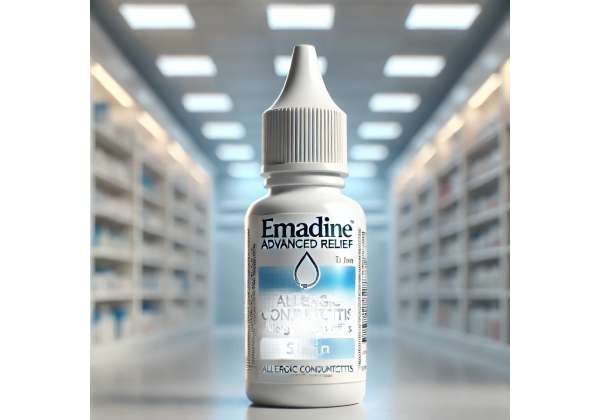A Fresh Look at Emedastine and Its Role in Ocular Allergy Relief
Allergic conjunctivitis is one of the most common eye conditions worldwide, affecting millions of people each year. It occurs when allergens—such as pollen, pet dander, dust mites, or molds—trigger an immune response in the conjunctiva, leading to redness, itching, tearing, and discomfort. For individuals who regularly battle these symptoms, finding reliable, fast-acting relief is a top priority. This is where Emadine, an Emedastine-based ophthalmic solution, steps in.
Emedastine is a second-generation antihistamine specifically designed for ocular use. Unlike first-generation antihistamines that often cause sedation or other systemic side effects, Emedastine demonstrates a lower tendency to cross the blood-brain barrier. This makes it more favorable for those needing potent, targeted relief without the drowsiness that can interfere with daily tasks. By blocking the H1 histamine receptors in the eyes, Emadine significantly reduces the inflammatory response that characterizes allergic conjunctivitis. As a result, users typically experience less itching, irritation, and redness soon after starting treatment.
Yet the benefits extend beyond simple symptom control. Emedastine also addresses some of the secondary problems linked to allergy-driven inflammation, such as persistent tearing or a sensation of grittiness. In some cases, individuals suffering from chronic allergic conjunctivitis might have difficulty wearing contact lenses due to constant eye irritation. By stabilizing the allergic reaction at its root, Emadine often facilitates a smoother, more comfortable experience for contact lens wearers. Beyond comfort, preserving the health of the ocular surface is crucial for overall eye wellness and the prevention of more severe complications.
The mechanism of action is grounded in a deep understanding of how histamines drive the allergic cascade. When foreign particles come into contact with the eye, immune cells release histamine and other mediators into the surrounding tissues. This creates a localized inflammatory response, typically with itching as the most bothersome symptom. Emedastine works by specifically binding to the H1 histamine receptors, preventing these receptors from becoming activated. Consequently, fewer inflammatory signals are sent, leading to a marked decrease in redness and itching.
Moreover, Emadine is formulated to be gentle on the ocular surface. Since eyes with allergic conjunctivitis can already be inflamed and sensitive, adding a harsh drop could compound irritation. By contrast, Emedastine’s solution is developed with tolerability in mind, minimizing stinging sensations upon instillation and reducing the risk of exacerbating underlying dryness or inflammation. These characteristics make Emadine a front-runner in delivering potent antihistamine effects with relatively few adverse reactions.
Because the prevalence of allergic conjunctivitis continues to rise in many regions—possibly tied to increased urbanization and pollution—therapies like Emadine are filling a critical gap. Rather than relying solely on oral antihistamines that treat systemic allergies, Emadine targets the ocular surface directly, potentially offering faster and more direct relief. For people who only deal with eye-focused allergy symptoms (rather than the nasal or skin manifestations), a localized treatment approach can be especially beneficial.
In this article, we explore everything from Emadine’s basic pharmacology to best practices for application, current clinical data on its effectiveness, safety considerations, and cost perspectives. Each section provides in-depth information for individuals seeking to make informed decisions on managing allergic conjunctivitis. Whether you’re a new patient dealing with itchy eyes for the first time or someone with recurring seasonal allergies looking for a better solution, understanding what Emadine has to offer can help you reclaim comfort and clarity in your day-to-day life.
Behind the Bottle: How Emedastine Ophthalmic Solution Works
At its core, Emadine’s active ingredient—Emedastine difumarate—serves as a potent histamine H1-receptor antagonist. Histamine, released by mast cells and basophils during allergic responses, has a key role in triggering blood vessel dilation, tissue swelling, and nerve stimulation. In the eye, this translates into the hallmark redness, itchiness, and tearing of allergic conjunctivitis. By interrupting the signaling pathway between histamine and the H1 receptors in ocular tissues, Emedastine effectively blunts these unwelcome reactions.
A Targeted Antihistamine Approach
In comparison to oral antihistamines, Emedastine operates at the site where allergic conjunctivitis starts—the conjunctival tissue. Oral antihistamines must pass through the digestive system and bloodstream before reaching the eyes, potentially leading to systemic side effects. Emedastine eye drops provide an almost immediate localized effect with minimal systemic absorption.
- Rapid Onset: Many individuals notice relief within minutes of applying Emadine, making it especially useful during high-pollen seasons or when confronted by sudden allergen exposure.
- Limited Systemic Distribution: Because the drops are topically applied, only trace amounts of Emedastine typically enter systemic circulation. This sharply reduces the risk of sedation or other systemic antihistamine effects.
- Longer-Lasting Effects: Emedastine’s formulation is designed for sustained action within the eye, which helps maintain symptom control without requiring overly frequent dosing.
Additional Anti-Inflammatory Activity
Beyond direct histamine blockade, second-generation antihistamines such as Emedastine may exert mild anti-inflammatory properties. While these effects are not as potent as those of dedicated corticosteroids or nonsteroidal anti-inflammatory drugs (NSAIDs), they can still be significant in easing redness and edema in the conjunctiva. By working on multiple levels—primarily histamine inhibition, plus mild inflammatory modulation—Emedastine fosters a calmer ocular environment, making daily activities like reading, screen time, or driving more comfortable.
Improved Ocular Tolerability
Another advantage is Emadine’s improved tolerability relative to older antihistamine formulations. First-generation antihistamines were often associated with burning, stinging, or dryness upon application, partially due to their chemical properties and the preservatives used. Modern formulations of Emedastine typically incorporate gentler preservatives and buffering agents to closely match the eye’s natural pH balance. This approach enhances patient compliance because drops that are less irritating encourage more consistent usage.
Contact Lens Compatibility
For contact lens wearers, allergic conjunctivitis can be particularly disruptive, leading to constant discomfort or forcing reduced lens-wearing hours. Some allergy eye drops are incompatible with lenses because they can cling to the lens surface or alter lens materials. Emedastine-based drops, however, are generally safe for use with contact lenses, assuming the user follows standard guidelines: removing lenses before administering the drops and waiting at least 10 to 15 minutes before reinserting them. This ensures that the active medication is absorbed into the ocular surface without significant interaction with the lens.
Pediatric and Geriatric Considerations
Clinical studies support the use of Emedastine in a broad spectrum of age groups, from pediatric to geriatric populations. Children often experience allergic conjunctivitis as part of broader atopic conditions, and older adults may have dryness or other comorbidities that complicate eye drop usage. Because Emedastine is relatively mild, it can be integrated into treatment plans for various ages, although a healthcare provider’s assessment is essential to verify suitability. The drops can also be considered during pregnancy or breastfeeding in certain cases, but medical consultation remains indispensable to weigh any potential risks.
Minimizing Rebound Effects
Some eye drops—particularly those containing vasoconstrictors—carry a risk of rebound hyperemia, where redness returns even worse once you discontinue use. Emedastine, as an antihistamine, does not function via vasoconstriction, so rebound is minimal. Over time, consistent use of Emedastine can stabilize the allergic response at the ocular surface, ideally resulting in longer intervals of symptom-free periods.
By dissecting the pharmacology and ocular interactions of Emedastine, we see how Emadine can deliver reliable relief. This helps patients focus on life’s priorities instead of the nagging itch or redness that accompanies allergic conjunctivitis. As research into ocular drug delivery progresses, Emedastine stands out for striking a balance between potency and safety, a combination that sets the stage for wide-ranging acceptance among eye care professionals and patients alike.
Practical Usage: How to Apply and Optimize Emadine for Allergic Conjunctivitis
Understanding how to administer Emadine effectively is crucial for achieving maximum relief from allergy-driven itching, redness, and irritation. Proper technique not only ensures that the medication reaches its intended target but also helps reduce side effects and contamination risks. Whether you’re a first-time user or a long-time allergy sufferer, following best practices can greatly improve your experience with Emedastine.
Preparing for Instillation
- Hand Hygiene: Always wash your hands thoroughly with soap and water before handling any eye drops. This simple step minimizes bacterial transfer to the eye, which could lead to infections.
- Shake the Bottle Gently: Certain formulations may require gentle shaking to ensure an even distribution of active ingredients, although Emedastine solutions are typically homogeneous. Checking the instructions or asking your pharmacist can clarify if shaking is necessary.
- Contact Lens Removal: If you wear contact lenses, remove them before applying Emadine. This not only prevents the drops from adhering to the lens but also ensures the medication fully contacts the ocular surface. Wait at least 10 to 15 minutes post-application before reinserting lenses.
Correct Instillation Technique
- Head Position: Tilt your head slightly backward or lie down flat. This angle helps the drops spread evenly.
- Lower Eyelid Pocket: Gently pull down the lower eyelid to create a small pocket or “shelf.” This is where the drop should go.
- One Drop at a Time: Aim the tip of the dropper bottle directly over the created pocket—usually around one inch above—and squeeze one drop. More than one drop can cause overflow and waste, though some professionals may occasionally recommend two drops if coverage is uncertain.
- Blink Sparingly: Close your eyes gently for about 30 seconds to one minute. Vigorous blinking can push the drops out of the eye. Instead, a slow blink or gentle lid closure helps the medication spread across the cornea.
- Nasolacrimal Occlusion: Some eye care specialists recommend gently pressing a finger against the inner corner of the eye (near the nose) to block the tear duct. Doing so keeps the medication on the ocular surface longer, promoting better absorption and reducing systemic drainage.
Recommended Frequency and Dosage
For most patients, the typical dosage of Emadine is one drop in each affected eye, twice a day (every 12 hours). However, your eye care professional may adjust this schedule based on the severity of your symptoms or response to treatment. If you have persistent, severe itching, they might temporarily recommend an increased frequency or adjunctive treatments like cool compresses or artificial tears.
Combining with Other Ocular Medications
If you’re using multiple types of eye drops—such as lubricants, antihistamines, or anti-inflammatory medications—eye doctors generally advise waiting a few minutes between each medication to allow proper absorption. In many treatment regimens, Emedastine is used first because it combats histamine-driven discomfort, paving the way for other therapies to work more effectively. Confirm with your healthcare provider or pharmacist the recommended order of application to maximize each medication’s benefits.
Potential Mild Side Effects
- Transient Burning or Stinging: A brief sensation of discomfort may occur right after instilling the drops. This usually subsides within a few seconds to a minute.
- Blurred Vision: Some patients may notice temporary blurred vision immediately after application. Blinking slowly and waiting a minute before focusing on screens or driving can help this resolve quickly.
- Headache or Taste Alteration: In rare cases, users report a minor headache or a strange taste at the back of their throat, possibly due to trace amounts draining through the nasolacrimal duct. These side effects are typically mild and short-lived.
Maintaining a Sterile Environment
- Avoid Tip Contamination: Do not let the dropper tip come into contact with your fingers, eyes, or any surface.
- Close the Bottle Tightly: Keep the cap sealed when not in use to preserve the drop’s sterility and effectiveness.
- Proper Storage: Most Emedastine bottles require room temperature storage, away from direct sunlight or moisture. Carefully read the packaging for any specific guidelines.
When to Seek Professional Advice
Though Emadine is recognized for its good safety profile, you should seek ophthalmologic guidance if you experience:
- Persistent or Worsening Symptoms: Infections or other conditions can mimic allergies, so a medical professional’s assessment is crucial if your eyes remain red, painful, or sensitive for days without improvement.
- Changes in Vision: Sudden vision changes, light flashes, or floaters might indicate a more serious eye issue requiring immediate attention.
- Allergic Reactions to the Medication: Symptoms such as swelling of the eyelids, severe redness, or itching that worsens after instilling the drops could point to a hypersensitivity reaction.
By following these usage guidelines and seeking medical advice as necessary, most patients can achieve significant relief from allergic conjunctivitis with Emadine. The combination of a user-friendly application process, rapid onset of action, and minimal side effects positions Emadine as a go-to solution for many looking to manage ocular allergies effectively.
Latest Research Insights: Clinical Validation of Emedastine’s Efficacy
A primary driver of Emadine’s popularity among eye care professionals is the growing body of clinical research supporting its efficacy and safety profile in combating allergic conjunctivitis. These studies often focus on how Emedastine compares to other antihistamines, whether it can reduce dependency on corticosteroids, and the patient-reported outcomes that capture real-world experiences. Let’s delve into notable research that highlights how this medication has solidified its standing in modern ocular allergy management.
Head-to-Head Comparisons with Other Antihistamines
Researchers have conducted multiple comparative trials looking at topical antihistamines such as olopatadine, ketotifen, and azelastine. These studies consistently show that Emedastine is:
- Equally Potent or Superior in relieving primary symptoms like itching and redness when measured against other leading antihistamine eye drops.
- Faster Onset with some participants reporting symptom relief within 15 minutes post-application.
- Well-Tolerated with a lower incidence of dryness or burning compared to older-generation or multi-action drops containing vasoconstrictors.
The Role in Reducing Corticosteroid Dependency
For moderate to severe cases of allergic conjunctivitis, eye care professionals sometimes prescribe topical corticosteroids to tame inflammation. However, long-term steroid use carries potential risks, including elevated intraocular pressure or cataract formation. Several observational studies have investigated whether consistent use of Emedastine can diminish the necessity for corticosteroids. Findings suggest:
- Less Frequent Steroid Pulse Therapy: Patients who incorporate Emedastine early in the allergy season often need fewer “rescue” doses of topical steroids.
- Stable IOP Readings: By reducing the reliance on steroids, the risk of steroid-induced glaucoma appears to decline.
- Better Long-Term Disease Management: Over multi-year follow-ups, participants maintained stable ocular health with fewer episodes of severe allergic inflammation.
Pediatric Efficacy and Safety
Children represent a significant proportion of allergy-related eye problems. Because many parents and caregivers prefer not to use potent medications without strong safety evidence, studies focusing on pediatric safety are pivotal. Clinical trials and real-world data indicate that Emedastine:
- Causes Minimal Discomfort upon installation, crucial for children who may be especially sensitive.
- Poses Low Systemic Risk due to minimal absorption, mitigating concerns about sedation or other systemic issues.
- Improves School Attendance and Performance by reducing the distraction of itching, tearing, and eye rubbing that can hamper a child’s concentration.
Geriatric Applications
Allergic conjunctivitis doesn’t discriminate by age, and seniors can experience more pronounced complications due to concurrent conditions like dry eye syndrome, blepharitis, or meibomian gland dysfunction. Studies exploring Emedastine use in older adults show:
- High Tolerability and minimal interference with common age-related comorbidities.
- Synergistic Benefits when combined with treatments for dry eye, as alleviating allergic symptoms can reduce ocular surface irritation and friction.
- Medication Interactions remain rare, but physicians generally monitor for polypharmacy issues—especially in older patients with multiple prescriptions.
Patient-Reported Outcome Measures (PROMs)
Quantitative measures like ocular itching scores and redness indexes are standard in evaluating antihistamine efficacy. However, patient-reported experiences provide rich insights into medication satisfaction and real-life applicability. Surveys and interviews often highlight:
- Prompt Itch Relief: Many respondents express relief within the first hour, a boon in daily scenarios like commuting, working, or studying outdoors.
- Sustained Comfort: Respondents note fewer episodes of late-day eye fatigue and dryness, likely attributable to Emedastine’s targeted activity and gentle formulation.
- Overall Enhanced Quality of Life: By controlling flare-ups, users often regain the freedom to engage in outdoor exercise, read for longer periods, and reduce undue reliance on oral allergy medications.
Expanding Research Horizons
Ongoing investigations into ocular allergy treatments often include Emedastine as a baseline comparator, underscoring its importance in clinical benchmarks. Some areas of emerging research include:
- Combination Formulas: Integrating Emedastine with other agents (like mast cell stabilizers) to see if synergy can yield even better results.
- Extended-Release Eye Drops: Pioneering drug delivery systems aim to prolong medication contact time with the ocular surface, potentially reducing the need for multiple daily doses.
- Biomarker-Driven Therapy: Preliminary data suggests that personalized allergy treatments, guided by biomarkers like specific IgE levels in tear fluid, could soon refine how and when Emedastine is used.
From large-scale randomized controlled trials to observational studies in real-world settings, the evidence consistently underscores Emedastine’s position as a reliable and patient-friendly approach to allergic conjunctivitis. The goal of these research efforts remains clear: enhancing ocular comfort and health by addressing the root causes of allergic inflammation without undue side effects. Given the strength of the existing clinical literature, Emadine’s role in everyday eye care protocols appears poised to remain pivotal for years to come.
Enhanced Comfort and Safety: The Impact of Emadine on Daily Eye Care
When managing allergic conjunctivitis, balancing efficacy with minimal disruption to one’s daily routine is paramount. Emadine has gained a dedicated following in large part because it effectively combats eye allergy symptoms without burdening users with a long list of side effects. Nonetheless, any medication—especially one applied directly to the sensitive ocular surface—merits a detailed safety overview. Delving into Emadine’s risk-benefit profile offers clarity on why healthcare providers frequently recommend it as a go-to option in allergy relief.
Alleviating Common Allergy Symptoms
- Immediate Itch Relief: Users frequently report noticeable improvement in itching, one of the most bothersome symptoms of allergic conjunctivitis, within minutes of applying Emadine. This swift action allows individuals to refocus on work, school, or leisure activities.
- Reduced Redness and Swelling: Thanks to Emedastine’s potent antihistamine properties, the inflammation that causes eye redness is often decreased, helping the eyes look and feel less irritated.
- Fewer Distractions: Constant itching or burning can severely hamper concentration. Emadine often curtails these interruptions, leading to a smoother daily routine.
Safety Features that Stand Out
- Lower Sedative Potential: Unlike older antihistamines that sometimes cause drowsiness, Emadine’s chemical structure and topical application keep sedation risk extremely low.
- Minimal Systemic Spread: Because most of the medication remains localized to the eye’s surface, only a minuscule fraction enters the bloodstream, limiting concerns like raised heart rate or blood pressure changes.
- Mild Preservative Formulations: Eye drop preservatives can irritate sensitive eyes, particularly among chronic users. Emadine’s formulations typically utilize modern preservatives or a gentle combination designed to preserve the solution without provoking dryness or surface damage.
Long-Term Tolerability
Some ocular allergy treatments are effective in the short term but not suitable for prolonged or recurrent use. For instance, prolonged reliance on topical decongestants can lead to rebound redness. In contrast, Emedastine-based regimens are often used throughout the entire allergy season—or multiple seasons per year—without significant risk of rebound or tachyphylaxis (diminishing response to a drug). This consistent performance is invaluable for individuals with year-round allergies or those living in areas with persistent allergen exposure.
Safety in Special Populations
- Pregnancy and Lactation: While it’s best to consult an obstetrician or ophthalmologist for tailored advice, Emedastine’s low systemic absorption generally indicates fewer pregnancy-related concerns than some oral antihistamines.
- Post-Surgical Care: After procedures like LASIK or cataract surgery, the cornea may be more vulnerable to inflammation. Emedastine can sometimes be used to mitigate allergy symptoms during recovery, although individual risk profiles vary.
- Concurrent Eye Conditions: For patients managing conditions like glaucoma or chronic dry eye, Emedastine typically doesn’t interfere with the action of standard treatments such as prostaglandin analogs or cyclosporine eye drops. Nonetheless, an eye specialist should confirm compatibility.
Minimizing Adverse Reactions
While severe side effects are rare with Emadine, a few potential issues can occur:
- Conjunctival Irritation: A small subset of users may find that any eye drop triggers discomfort. A switch to single-use, preservative-free vials can sometimes resolve this.
- Allergic Reaction to Inactive Ingredients: Though uncommon, hypersensitivities to certain preservatives or buffer agents may manifest as itching or eyelid swelling.
- Excessive Tear Production: Some individuals experience watery eyes in the initial phase, which usually subsides as they adapt to the medication.
Handling Potential Complications
If you notice persistent discomfort, increased redness after consistent use, or signs of infection like discharge or intense pain, promptly consult a qualified eye care professional. They can perform diagnostic tests—ranging from slit-lamp exams to tear film analyses—to determine if the reaction stems from the drops themselves or an unrelated issue.
From a holistic standpoint, Emadine stands as a strong contender for those seeking immediate and lasting relief without sacrificing comfort or introducing unnecessary risk. Its proven performance in clinical settings and broad acceptance among specialists highlights Emadine’s value in modern allergy management. Ultimately, the combination of localized action, mild formulations, and a robust track record cements Emadine’s reputation as an indispensable tool in the fight against allergic conjunctivitis.
Therapy Price: Planning for Emedastine Eye Drops
Depending on the pharmacy, insurance coverage, and brand availability, Emadine (Emedastine) eye drops often range from about \$20 to \$50 per bottle. Some pharmacies may offer generic versions at a slightly lower price, while brand-name solutions can be at the higher end. Patients without insurance might find benefit programs through the manufacturer or third-party discount cards, which can reduce out-of-pocket costs. Bundle deals or multi-pack purchases could also yield savings for those who require regular refills throughout the year. If budget constraints arise, consulting a healthcare professional about suitable alternatives or generics helps ensure continued relief without financial strain.
Disclaimer: This article is meant for general informational purposes only and does not replace professional medical advice, diagnosis, or treatment. Always consult an eye care specialist or other qualified healthcare provider for personalized guidance.
We invite you to share this article with anyone who may benefit from learning more about Emadine and allergic conjunctivitis relief. You can use our Facebook and X (formerly Twitter) share buttons or any social media platform you prefer—your engagement helps spread valuable information and fosters better eye health in our communities.













